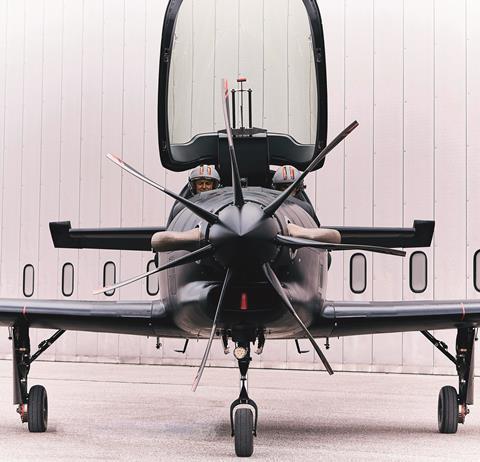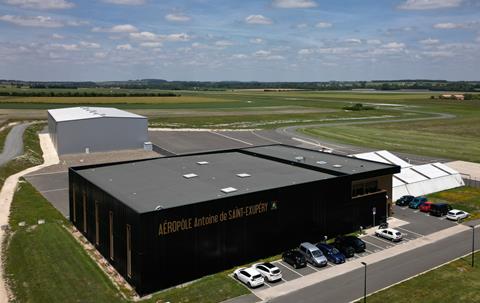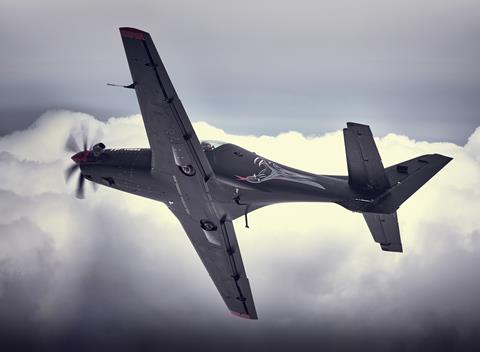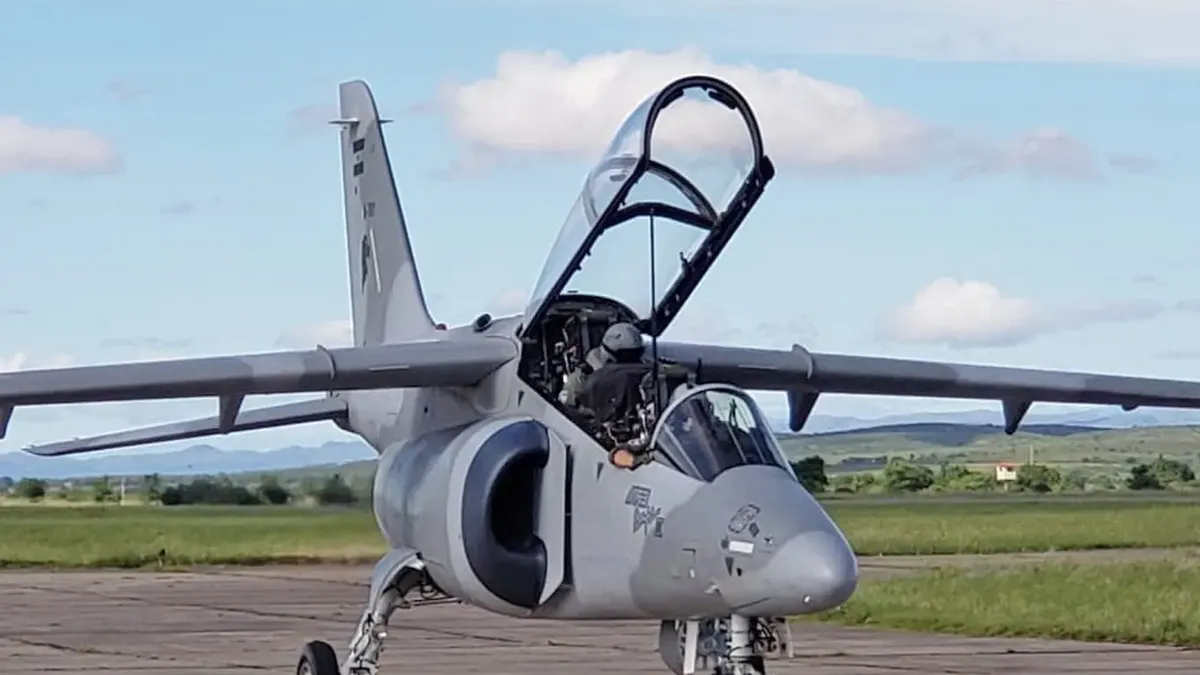Grob Aircraft France launches TPX Cobra trainer, with ISR version to follow
By
 Craig Hoyle
Craig Hoyle20 June 2024
Newly formed Grob Aircraft France (GAF) is lifting the lid on its TPX Cobra two-seat trainer: a design initially being pitched to its home nation, but which could also be developed for broader applications.
To be displayed in model form for the first time on 28 June, during an event at the Palace of Versailles near Paris to mark the 90th anniversary of the French air force’s formation, the aircraft is the result of a secret multi-year development activity.
Source: Grob Aircraft France
TPX Cobra has side-by-side seating to optimise early pilot training activities
The project began in Germany last decade, as Mattsies, Bavaria-based Grob Aircraft studied a larger addition to its portfolio, seeking a new product to sit above its G120TP.
Described as an evolution of the high-end turboprop – more than 200 of which are in service in support of air forces on five continents – the new model uses some common equipment, such as its electrics, fuel system and landing gear.
ADVERT
Also drawing on the company’s decades-long experience in producing all-composite types, the result is a sleek design some 9.92m (32ft 5in) long and with a wingspan of 11m. Its design philosophy meant the trainer retains the side-by-side seating configuration of a product range which also counts the earlier G120A.
GAF chief pilot Damien Dufour points to the advantage of early training taking place side-by-side, noting: “You can move quicker in correcting your student, and you don’t miss anything. And you make the student more confident – especially at the beginning – because they have the instructor right beside them.”
Additionally, only around one-third of a military’s students typically will progress through the training pipeline to fly a fast jet, with the remainder to instead operate transport aircraft and helicopters where side-by-side seating is the norm.
Power comes from a Pratt & Whitney Canada PT6A-25C engine producing 750hp (560kW), which drives an MT-Propeller MTV-37 seven-bladed, low-noise propeller with a 2.1m diameter. Maximum speed is cited as 250kt (462km/h), and its take-off roll is 449m in standard configuration.
Source: Grob Aircraft France
Model features a seven-bladed propeller and single-piece canopy
With a maximum take-off weight (MTOW) of around 2.7t, the aircraft will be fitted with Martin-Baker Mk10L ejection seats with zero-zero performance (referring to the escape system’s minimum operating altitude and speed).
ADVERT
Both the student and instructor pilot will have a head-up display and two multifunction displays, with the type using Genesys Aerosystems’ Oasis open architecture avionics. This “provides the aircraft OEM, integrator, or operator tremendous capability to interface with new devices and add new capabilities without the complexities associated with certification requirements”, the supplier says.
While most airframers can barely open a hangar door before their new products are spotted and photographed by local aviation enthusiasts, the remote rural location of Grob Aircraft’s site helped it to keep the TPX Cobra a closely guarded secret.
The company performed a first flight with the new design in May 2019, and activities continued through and beyond the Covid-19 pandemic. As of mid-June 2024, more than 250 flight hours had been accumulated by the lone, “production-representative” prototype.
TECHNOLOGY TRANSFER
GAF has purchased the TPX Cobra technology from Grob Aircraft, with the approval of Germany’s export agency. The new owner’s preparations to advance the programme are at a key stage, with a new hangar having recently been completed at Saint-Germain-de-Lusignan airport near Jonzac, northeast of Bordeaux.
ADVERT
The manufacturing location has been chosen due to its proximity to the French air force’s Cognac air base – a potential future operating site for the TPX Cobra – and to take advantage of local authority incentives to help establish an aerospace industry hub in the area.
The new 2,500sq m (26,900sq ft) facility will open its doors for operations later this year. Some equipment has already been installed, including an autoclave for preparing composite material, and tools and jigs will be transferred from the Mattsies site later this year, as they also were included within the sale of the technology.
Source: Grob Aircraft France
Grob Aircraft France has built new hangar near Jonzac in France to house its actitivies
Production details have yet to be finalised, but the original developer could continue to supply key equipment including the main fuselage structure, which has an operating life of up to 15,000h.
Currently in its competitive phase, France’s Mentor2 programme is seeking a new type to deliver Phase I (screening) and II (elementary) training services at Cognac and Salon-de-Provence air bases.
ADVERT
After screening student pilots, the selected trainer also will support initial training, including instruction in tasks such as low-level, aerobatic and formation flight, plus operations under instrument flight rules.
Paris is looking to acquire 22 trainers, plus three for use by its DGA defence procurement agency. The new fleet will replace Cirrus SR20/22s and G120As currently made available under a deal with the Airbus Flight Academy.
A platform selection is anticipated before the end of 2024, with additional contenders understood to include a Dart-series offering from Diamond Aircraft and Pilatus’s new-generation PC-7 MKX: tandem-seat models. Both companies declined to comment when contacted by FlightGlobal, however.
GAF believes the Mentor2 requirement could be worth €1 billion ($1 billion) over an 18-year period of service delivery, with the winning contractor also to oversee the provision of supporting infrastructure such as hangars, classrooms and simulators. A first aircraft delivery is due in January 2026, to support testing and syllabus development work.
FLEET RENEWAL
The French air force’s earlier Mentor1 activity has already seen Pilatus supply 26 PC-21 turboprops for use during Phase III and IV instruction, via a partnership with Babcock International. These were acquired to replace obsolete Dassault/Dornier Alpha Jet trainers.
ADVERT
A former French air force Dassault Mirage 2000-5 pilot who also has worked as an instructor pilot flying the PC-21 in support of the Qatar Emiri Air Force’s training system, Dufour is highly impressed by GAF’s new product offering.
“It’s an extremely comfortable aircraft,” he says. “The stability is superb – the platform is very well balanced, and it is super-quiet.” He also praises the “excellent all-round visibility” afforded by its large one-piece canopy, which also makes for a distinctive feature when opened on the ground.
Source: Grob Aircraft France
GAF chief pilot Damien Dufour (
left) describes new type as having superb stability in the air
Other innovations include the installation of an inspection panel on the starboard fuselage side, which will support and simplify maintenance procedures. The TPX Cobra is being offered using a condition-based maintenance model, rather than having parts replaced according to a fixed time between overhaul methodology. The aim is for the aircraft to require only 25-30min of maintenance effort per flight hour, GAF says.
Civil certification is being sought for the aircraft, which will enable it to be used by training providers when delivering services and equipment to military customers as civilian-registered assets. A roughly one-year flight-test process involving European Union Aviation Safety Agency (EASA) pilots is expected to commence in September. Certification and full service entry is likely to be achieved by early- to mid-2027.
| TPX Cobra specifications | |
|---|
| Dimensions | |
| Length | 9.92m |
| Height | 3.6m |
| Wingspan | 11m |
| Weights | |
| Maximum take-off weight | 2,722kg |
| Maximum landing weight | 2,722kg |
| Engine | |
| Pratt & Whitney Canada PT6A-25C | x 1 |
| Maximum power | 750shp |
| MT-Propeller MTV-37 (seven-bladed) diameter | 2.1m |
| Performance | |
| Take-off roll* | 449m |
| Landing roll* | 295m |
| Operating ceiling | 25,000ft |
| Maximum airspeed** | 250kt |
| Load factor | +4.4 to -1.7g |
| Maximum range*** | 865nm |
| Flight endurance | 6h |
| Source: Grob Aircraft France Notes: *standard configuration **to 16,450ft ***long-range cruise speed, 10,000ft | |
Meanwhile, GAF also is seeking to secure an air operator certificate from EASA to enable it to begin delivering training services on the G120TP from its site near Jonzac from the last quarter of this year.
ADVERT
“We have some customers interested,” Dufour says, without elaborating.
INTERNATIONAL MARKET
Meanwhile, in unveiling its new model during the French air force’s 90th anniversary celebrations, the company also will be revealing the product to the international market, since around 55 delegations are due to be at the event.
And the company’s ambitions already extend beyond the trainer role, with it seeing the platform as holding the potential to undertake a broader range of duties.
Its plans for a potential ‘TPMX’ version start with a so-called ‘Mission’ model, adapted for intelligence, surveillance and reconnaissance (ISR) tasks.
With the current design featuring free space behind the cockpit area, GAF plans to install an electro-optical/infrared sensor – potentially up to a 25in-diameter ball turret – to support ISR tasks. This could be retracted into the fuselage when not in use, for protection if operating from an austere landing site.
Source: Grob Aircraft France
Proposed ‘Mission’ variant would carry surveillance equipment and additional fuel
Alternatively, the aircraft could be equipped with a lightweight maritime search radar, which would be fitted beneath its fuselage.
GAF believes that if also equipped with external fuel tanks – each with a 270l capacity – the Mission variant could have an operating endurance of around 6h. If permanently adapted for such a task, the left-hand seat’s flying controls would be removed, freeing up space to accommodate a dedicated observer station.
Such an aircraft could receive strong demand from operators in regions like Africa and Latin America, the company says.
Also for ISR applications, the French firm says an optionally-piloted development could be pursued. Its concept would be for the aircraft to be flown to a forward location by a pilot before being modified to undertake long-endurance sorties in an unmanned condition. Fitted with additional fuel capacity and potentially a longer wing, the platform could be capable of remaining airborne for 10-12h.
Beyond this, it also believes an opportunity exists to adapt the TPMX for light counter-insurgency operations. If advanced, this would see the aircraft receive a new wing designed to accommodate two weapons pylons per side.
Dufour notes that many nations either do not need or cannot afford to operate dedicated fighter aircraft as they seek to tackle issues like drug trafficking, but require a versatile, low-cost asset with affordable operating costs.
Taking advantage of its small size and low noise signature, the aircraft could carry light stores such as guided rockets; it would not use gun pods due to their limited effective range. The enhanced wing also would feature protection against damage from small arms fire, and ballistic protection would be provided beneath the engine and cockpit. Such development activities could see the aircraft’s MTOW increase to around 4t.
COMMON PARTS
All versions of the aircraft would retain a high level of parts commonality, projected to be 80-90%, GAF says.
“The whole programme makes sense,” Dufour says. “Perhaps we could sell 200 TPX trainers over 20 years. If we do the Mission and other versions, maybe we could sell 800.”
An ambitious newcomer, GAF could potentially enjoy its first success within the coming months, if Paris backs it for the Mentor2 requirement. An early win and high-profile endorsement from its domestic customer would surely help the TPX Cobra to strike more deals around the globe over the coming years.

 Craig Hoyle
Craig Hoyle










 jala que la dirigencia argentina vea alguna vez esta posibilidad de generar trabajo de alta calidad con Fadea.
jala que la dirigencia argentina vea alguna vez esta posibilidad de generar trabajo de alta calidad con Fadea.